|
Although none of them
is worth a visit unless you are an archæologist, the uplands north-west
and south-east of Saint-Antonin have a density of megalithic tombs to
match that farther north in the Lot; this group is really a southern
outlier of the hundreds of very similar dolmens surviving on the
causses, aligned towards the rising sun and tending to occur in
places with chalk slabs surfacing through the limestone of the Upper
Jurassic period. They have rectangular or trapezoidal cairns.
Several have been systematically excavated, with interesting results,
and two, the adjoining "boxed tombs of Le
Pech" between Penne and Caussade, have had their rectangular
cairn entirely 'restored'
almost à la Newgrange, complete with ugly and intimidating
fence. These tombs, like most in the area, have a short entrance passage
leading into a simple roofed chamber. The W tomb was covered with cairn
material after excavation, though part of it was visible before.
The other tombs in the
commune of Saint-Antonin are in a ruinous to very ruinous state, and
some I was unable to find. The nearest tomb to Saint-Antonin is at
La Canelle on the Pech Dax NW of the village. It is marked on the
map and visible from the track.
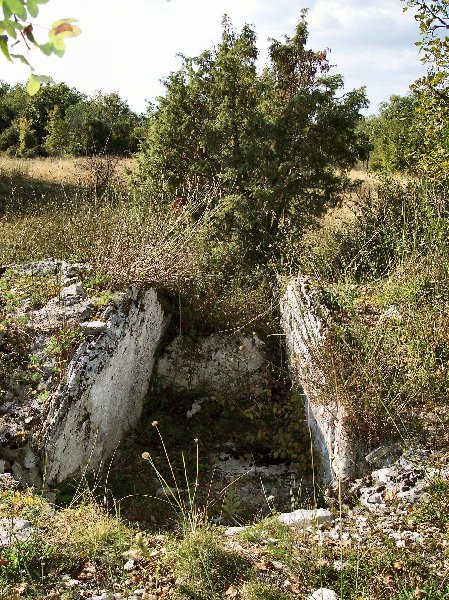 La Canelle
La Canelle
Although
this tomb is roofless, its cairn
or tumulus has survived, and the chamber is at something like its
original depth. This is not the case with the Dolmen de Clauset no.1,
the easiest of the Saint-Antonin tombs to find, and worth visiting if
only for the splendid view over the Aveyron Gorges from nearby.
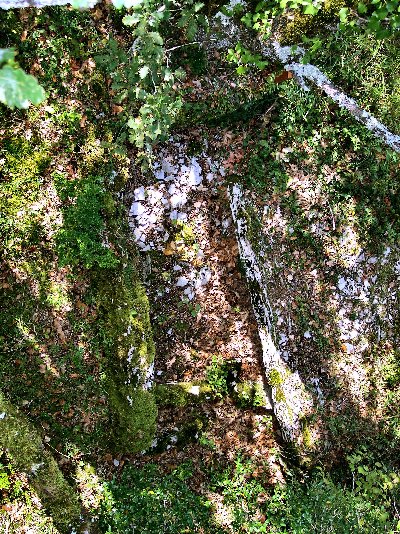 Clauset
No.1 Clauset
No.1
|
Il
est situé sur le bord droit du chemin allant au hameau
de la Veyrie (pancarte : Poterie de Grès) et
au-dessus des Gorges de l'Aveyron.
Pour le trouver, il faut emprunter le premier chemin sur la droite
de la route D5 entre Saint-Antonin-Noble-Val et Septfonds.
Le dolmen de Clauset n°1 est situé environ une cinquantaine
de mètres avant une fourche de cette petite route.
Un panonceau en bois « DOLMEN: VESTIGES »
signale ce dolmen quasiment ruiné. C'est l'un des
24 tombeaux mégalithiques inventoriés sur la commune
de Saint-Antonin. Dans les proches environs, 4 autres dolmens
(vestige d'une nécropole ?) sont connus (à moins
de 300 mètres).
Ils on tous
fait l'objet d'études et fouilles (1988-1992) sous la direction
de M. Bernard Pajot (C.N.R.S. Toulouse). Il s'agit de mégalithes
funéraires ayant contenu de nombreuses sépultures
successives sur un période de plusieurs siècles
- 15 à 25 siècles avant le commencement de notre
ère.
Ce
dolmen a subi d'importantes dégradations: sa dalle de couverture
a disparu, son tumulus est largement effondré et même
détruit du côté de la route (monticule entourant
le dolmen).
De
l'exploration méticuleuse on y a trouvé de sépultures
(dents, fragments d'ossements, etc.) qui ont permis de déterminer
l'âge et le nombre de sujets ensevelis; d'éléments
de parures (perles, anneaux, pendeloques); d'armes (points de
flèche, de lance, poignard, en silex); d'outillage (lames,
fragments de meule, percuteur, galet, etc.); et de poterie (vases,
gobelet).
"Ces
vestiges nous disent que nous marchons sur les cendres de ceux
qui nous ont précédés il y a 40-50 siècles
dans la contrée où nous vivons!
"Nous nous
devons d'assurer la pérennité de ce site en le respectant
- Merci."
|
Situated on the right-hand side of the untarred road leading to
la Veyrie (signposted Poterie de Grès), which overlooks
the dramatic Aveyron Gorges and is the first on the right on the
D.5 from Saint-Antonin to Septfonds, some 50 metres before a fork
and beneath a wooden sign labelled DOLMEN: VESTIGES),
this largely-destroyed tomb is one of 24 reported in the commune
of Saint-Antonin - four of which (remains of a necropolis ?) are
nearby at distances of less than 300 metres.
These
four tombs werre carefully excavated from 1988 to 1992 under the
direction of Bernard Pajot, who established that these were megalithic
tombs containing several successive interments over a period of
several centuries, some 15 to 25 centuries before the beginning
of the Christian era.
This
tomb has been fairly wrecked, and its tumulus used as road-material.
The capstone has disappeared or been smashed.
The
excavations uncovered teeth and fragments of bone which permitted
a fair estimate of the age and number of the interred. Fragments
of personal ornaments (pearls, rings, pendants) were found, as
well as flint arrow- and spear-heads, and dagger blades. There
were also fragments of pottery (vases, drinking vessels) and remains
of tools such as blades, grindstones, hammer-heads and pebble-tools.
The
hand-written notice from which this information is taken also
declares:
"These
remains remind us that we walk on the ashes of those who preceded
us by 40 or 50 centuries in the land where we live.
"We
must respect this site to ensure that it remains. Thank you."
|
Two more
tombs are reported close to Clauset No.1. Clauset No.3 is stated to
be 150 metres E of Clauset No.1, and Clauset No.2 is stated to be a
further 200 metres SE. But I have been unable to find them, and conclude
that they must be under dense shrubbery.
There
are, however, two tombs in different lieu-dits nearby (on the
other side of the track) which can be found, though it is hardly worth
it. The Dolmen de Las Gamasses
is 500 metres NE, just past the electricity sub-station and 75 metres
from the track. The Dolmen de Gastinel
is about 600 metres NW, about 200 metres W of the PR 12, very near a
spoil-heap of a new villa farther to the W. It is hardly visible amongst
the undergrowth.
Click
for another picture 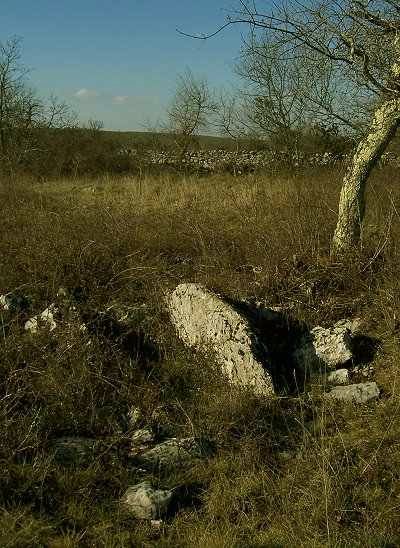 Gastinel
Gastinel
By far the most interesting tomb in the commune is the Dolmen de
Clauzel/Clausel, which is not to be confused with Clauset (above)
and is some 3.6 kms S by E of Saint-Antonin on the other side of the
river in the Albigeois. Although it is very close to a wide but rough
track, it is unfortunately difficult of access because it is behind
the high fence of a weekend or summer property.
Its co-ordinates are:
44.12208367002676, 1.7590570449829102.
It is remarkable that
it was long ago christianised with a cross incised on its Eastern roof-stone.
Though christianised menhirs are
frequent in Brittany and Western France, christianised tombs are exceedingly
rare. I know of no other in France, apart from a monolithic cross erected
close to a dolmen
farther north which is on the old Pilgrim Path to Santiago. I know
of none amongst the hundreds of tombs I have visited in Ireland.
The cross on the tomb at Clauzel is not, like some crosses on menhirs,
of crude or recent execution, but is an equal-armed cross whose expanded
terminals are typical of the period from the 6th to 9th centuries, and
of a type found at Early Christian monastic
sites in Ireland.
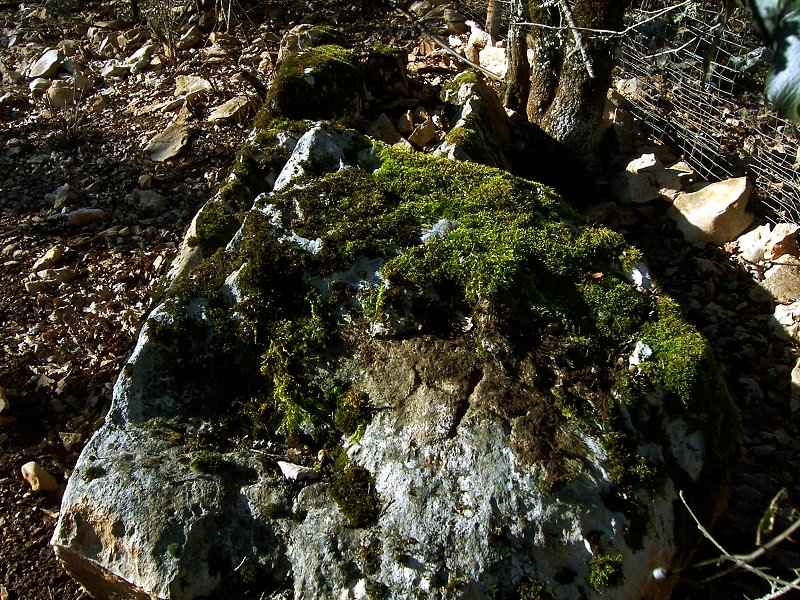
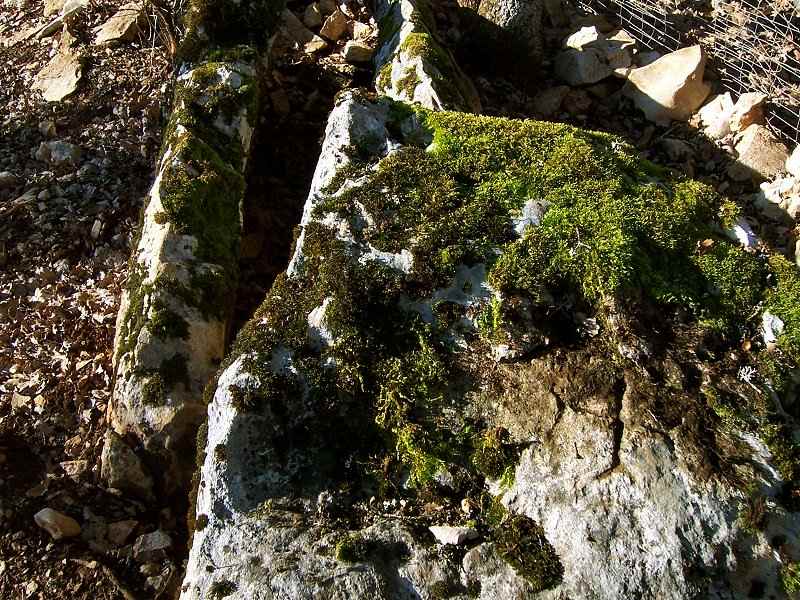
This kind of cross clearly suggests the crucifixion
by the top arm having no terminal.
To the left of this fragment of roof-stone is one of the side-stones
of the chamber.
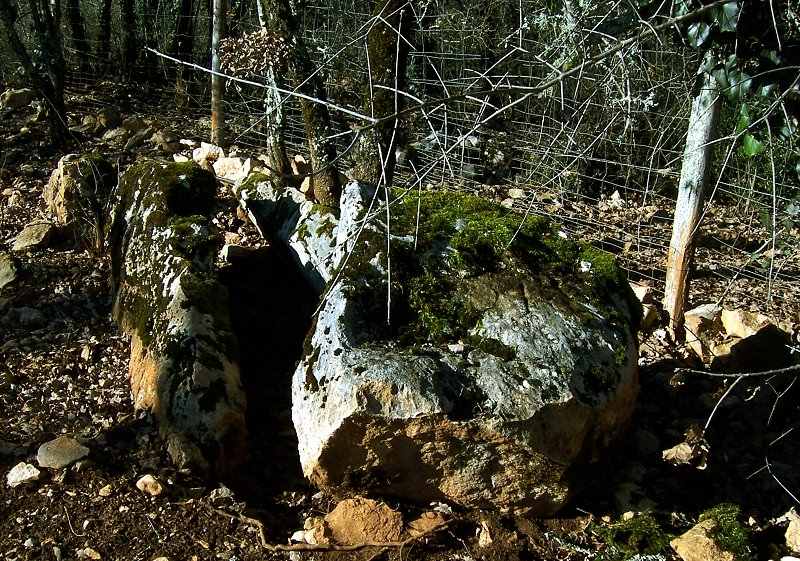
The complete tomb from the front. (These tombs almost
always face the rising sun.)
The roof-stone has been dragged forward, and the break looks as if it
occurred in the 20th century.
The chamber is very narrow.
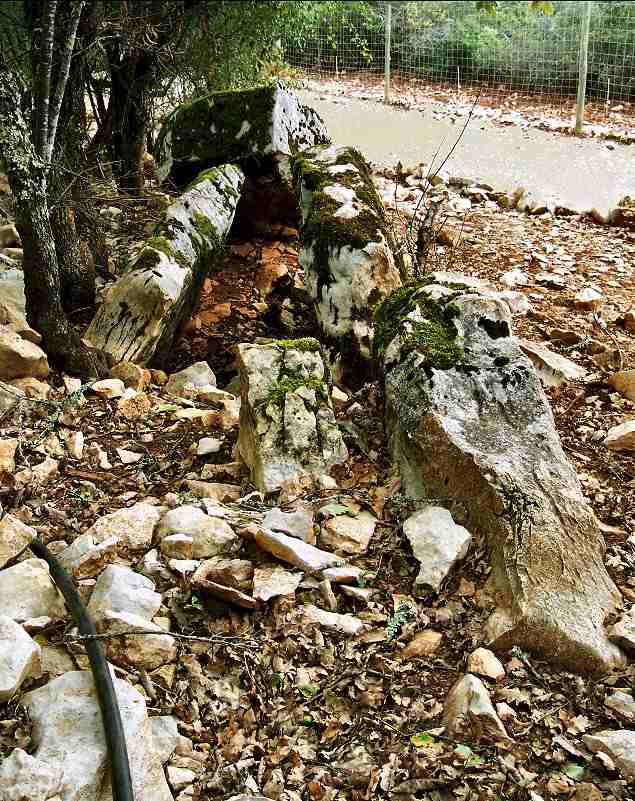
The tomb from the rear.
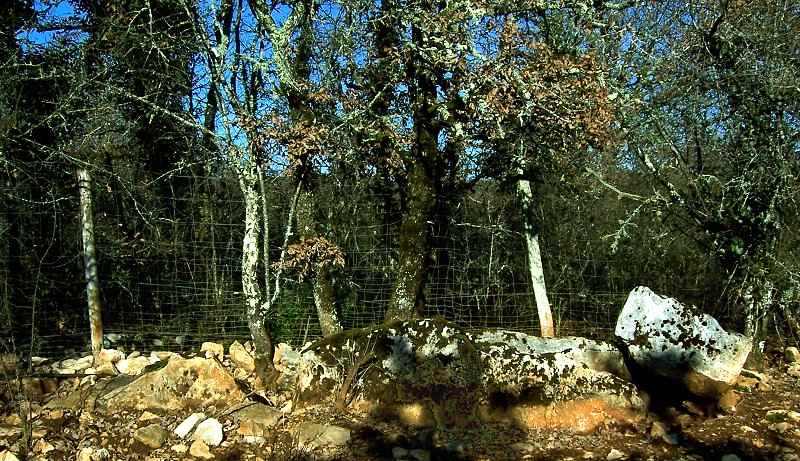
The tomb from the South, with the roof-stone on the
right. On the far side is a boar-proof fence
erected in the 1980s. On this side a new driveway to a second (summer)
home has been created,
which has done a little damage to the cairn, but has made the tomb easy
to find.
The Clauzel tomb is not difficult to
find - though I discovered it right in front of my eyes only on the
third attempt! It is 3.5 km S by E of the bridge of Saint-Antonin, at
a point 0.8 km (0.6 miles) down a wide but pot-holed track running SE
from the GR (chemin de Grande Randonnée) 46, behind a
modern metal fence and gateway (on the left) which is usually locked.
For a tomb Christianised very differently, a few kilometres North of
Saint-Antonin, also on the GR 46,
click here.
For an exhaustive study of all the megalithic tombs of Saint-Antonin
(with no mention of the Neuf Pierres which may have stood on
the flood-plain of the little Bonnette river close to the town, and
served a different ritual function for the same population) see the
superbly-produced LES DOLMENS DU PECH ET LE MÉGALITHISME
DE SAINT-ANTONIN-NOBLE-VAL, by Bernard Pajot and others,
Toulouse & Caussade, 1996, which has plans and colour plates of
all the surviving tombs, plus a summary in English. This book is in
the municipal library (Médiathèque Amélie Galup)
of Saint-Antonin.
The photos below of the
Boxed Tombs of Le Pech, on the
D.75b between Penne (whose Cathar castle was burned by Simon de Montfort
in 1211)
and Caussade (former centre of the hat industry), have been taken from
that work.
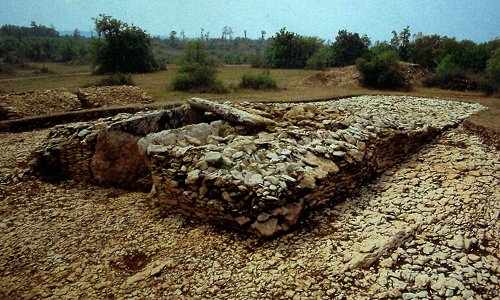
The main tomb and the cairn after excavation but before
'restoration' and fencing.
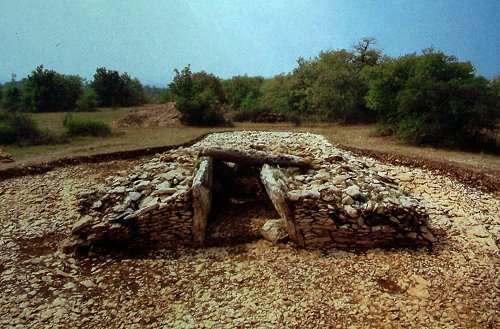
Looking directly into the passage and the main chamber,
and through to the secondary chamber at the West end.
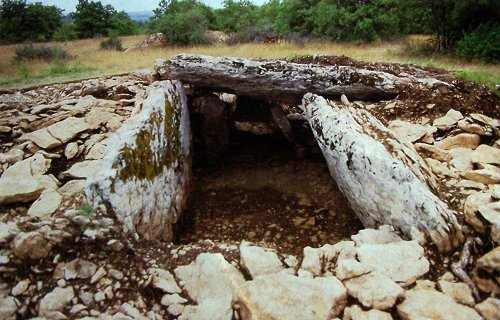
A closer view from the E.
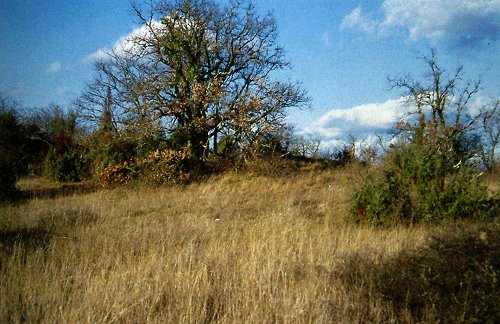
The site from the left (road) side before clearance
and excavation.
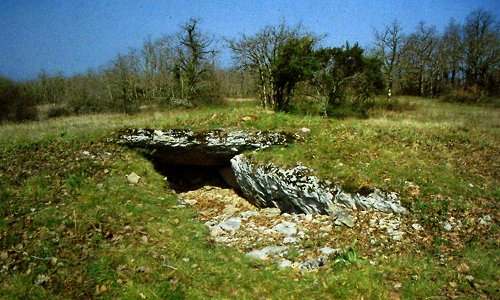
The site from the West before clearance and excavation,
showing the second and secondary chamber now covered by the 'restored'
cairn.
Not far away from this dolmen, and
E of the same road, is the much-better-preserved and beautiful Tombeau
du Géant at
Saint-Cirq,
also known as Septfonds Dolmen no.4
(click here
for other Septfonds dolmens).
12.5 km
S by E of Saint-Antonin (and in the Albigeois) are the remains of a
tomb at La Fage,
on the E side of an un-numbered road which cut through its cairn in
the forest of Grésigne,
and marked on IGN 1:25,000 sheet 2141E.
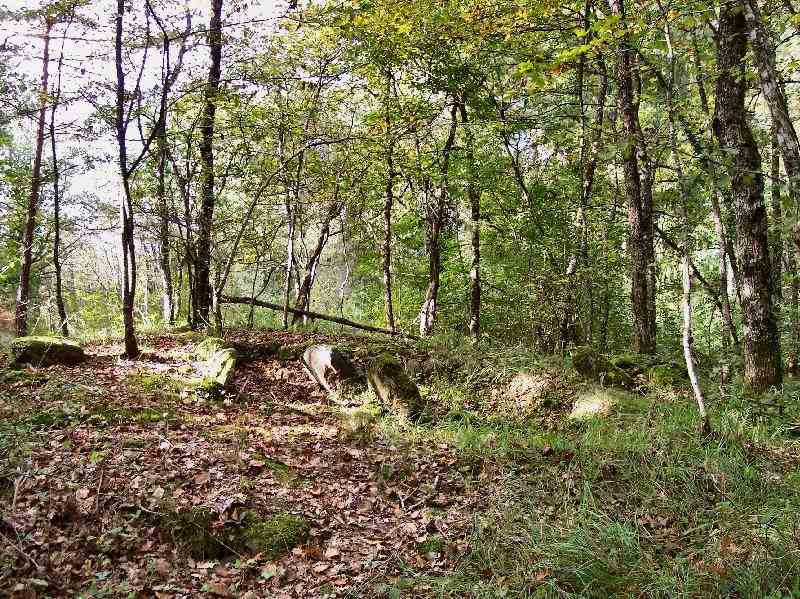
N44.04265 : E1.79489
|
![]()
 La Canelle
La Canelle Clauset
No.1
Clauset
No.1 










